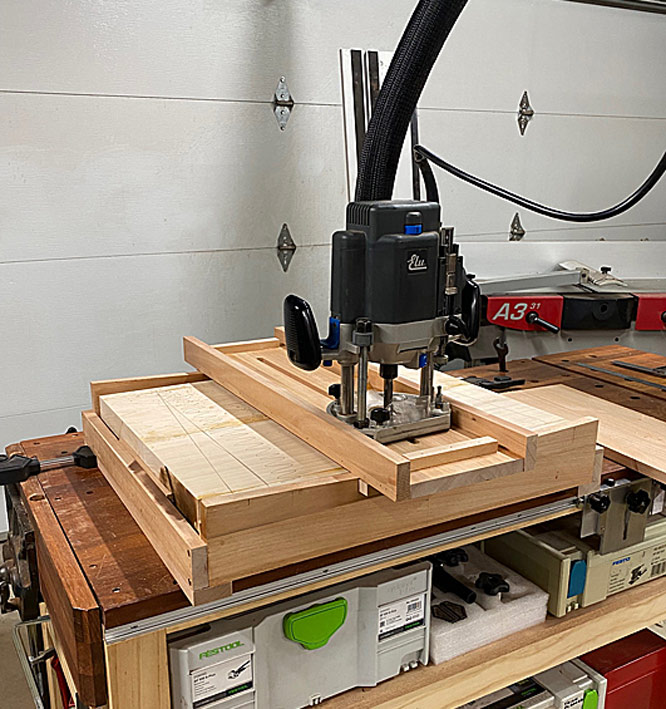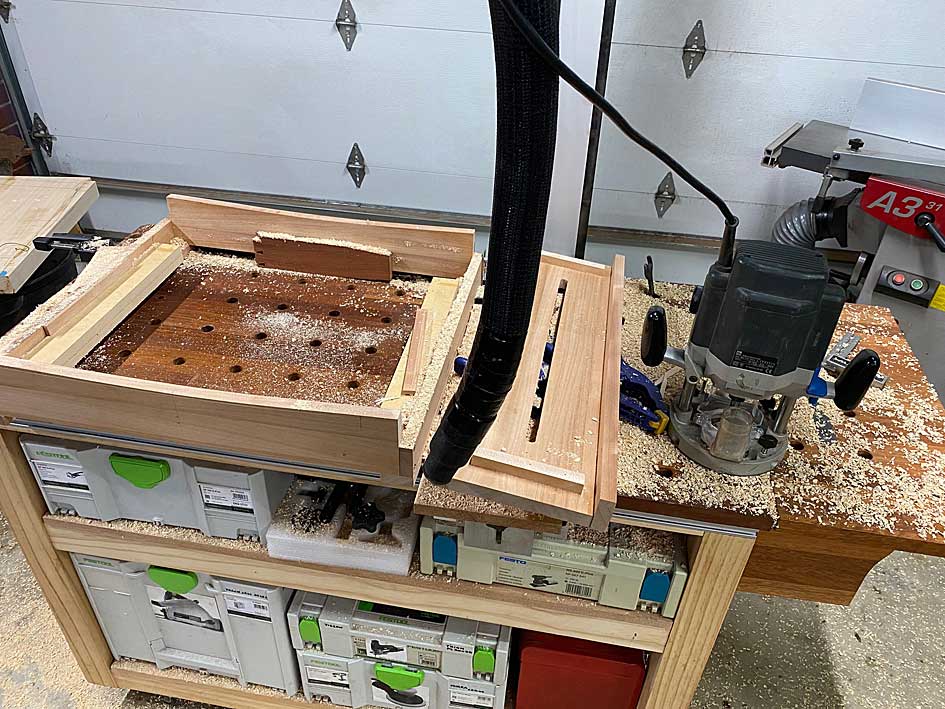Cabinetman
Established Member
That is a seriously beefy underframe! Most benches wouldn’t need the middle row at all, hopefully you have checked the width against the door opening?
Ian
Ian

Surely no body has ever done thathopefully you have checked the width against the door opening?
Presumably you know by now that I meant the workshop door if you ever want to move the bench.It is certainly a beefy thing.
The middle row is for storage more than strength really.
How do you mean checked the width against the door opening? I don’t intend to put any doors on the bench.
Ha Yeah just re-read your message and got what you mean. I had thought that one through fortunately!Presumably you know by now that I meant the workshop door if you ever want to move the bench.
Removals friend of mine was asked to move a houseful including the beautiful handmade Indian probably Rosewood cabinet in the sitting room. No way hosey, built it in the room!






Hey Derek, what’s the main reason you’d not bother with having the Mft? Because of the holes and mess?Calum, you may wish to re-consider the MFT-as-a-hand tool bench. All those dog holes will drop dust and shavings below, and you will come to hate this.
Also, I see no benefit in a split top, only more maintenance.
Your base is looking good for a hand tool bench. I would keep it for that purpose. I have some decades of experience here. See my earlier post for photos.
Regards from Perth
Derek
Thats really interesting to hear. Now you mention it I think I’ve heard of someone doing the 3mm holes-only idea before. Makes a lot of sense!I have an mft bench with all its holes, and I also have another bench that I intended to be purely for assembling finishing. I inherited a very solid welded steel frame 8 ft x 2 ft 6 that is so heavy I need help to move it even by inches. I Bolted an 18mm ply top on it and found that I tended to do more actual wood work on it than intended. I have the mk 1 park guide bought on this forum when I had a lot of sheet stuff to do impractical on the mft. I put enough full size holes in to mount the benchdogs fence, including the right hand side fence, and one full hole on my side of the table for 90 degree cuts. At the same time I put 3mm holes that the mk1 system uses as a guide all round the worktop which means I can quickly add extra 20mm holes accurately if really needed. Nothing drops through the 3mm holes! I use this bench way more often than the mft. I have replaced the top on the big one more than once. It currently has an 8 x4 ft top, and currently has the basic 6 holes for benchdogs tracksaw use.
So my use has evolved and I didn’t get it right first time.
Hey Derek, what’s the main reason you’d not bother with having the Mft? Because of the holes and mess?
The design isn’t fixed, very much open to ideas still.
The main thing for me though is that an mft-style table would be a real help.
Currently in my shared workspace we have no quick and easy way of cutting sheets 90° or 45°. I know that most of the holes wouldnt end up getting used, maybe it would be worth being selective with which ones to drill rather than the full grid?
I’d love to have a dedicated hand tool bench but space is limited, hence the hybrid design.




You still need the guide. Two 3mm pins hold the guide in place whilst you are drilling the big hole using elsewhere on the guide.Thats really interesting to hear. Now you mention it I think I’ve heard of someone doing the 3mm holes-only idea before. Makes a lot of sense!
I’ve never used a parf guide but plan to. Once you’ve drilled the 3mm holes, is the guide still needed? Or do you just re-drill with a 20mm bit?
Calum, I am not saying not to build a MFT, just that this is different from a hand tool bench, both in construction and use.
My MFT is on wheels. It is a sold bench and I can plane boards on it, but the wheels cause it to rock, and to a long-term hand tool user this is not ideal. The MFT is a great bench for lighter demands, such as power tool use. The benches excel at different tasks, and their use does not overlap well. Build a Jack-of-all-trades and you end up with average at all, and nothing particularly great.
Chips and dust can and do drop through the holes on both.


Actually, more mess is made on the Roubo bench, but there are fewer dig holes involved.


The solidness of the Roubo is so important when working with hand planes or hand saws.
Regards from Perth
Derek
Hey Derek, yeah I totally get what you mean. Nine times out of ten I’m of the opinion to have dedicated solutions to specific problems too.Calum, I am not saying not to build a MFT, just that this is different from a hand tool bench, both in construction and use.
My MFT is on wheels. It is a sold bench and I can plane boards on it, but the wheels cause it to rock, and to a long-term hand tool user this is not ideal. The MFT is a great bench for lighter demands, such as power tool use. The benches excel at different tasks, and their use does not overlap well. Build a Jack-of-all-trades and you end up with average at all, and nothing particularly great.
Chips and dust can and do drop through the holes on both.


Actually, more mess is made on the Roubo bench, but there are fewer dig holes involved.


The solidness of the Roubo is so important when working with hand planes or hand saws.
Regards from Perth
Derek
Ah ok thanks Stuart that’s handy to know. Still could be a sensible option if not wanting to commit to an entire top of holesYou still need the guide. Two 3mm pins hold the guide in place whilst you are drilling the big hole using elsewhere on the guide.
Blimey a 12” workbench! Makes sense though if you’re building large scale stuff I suppose!I like Peter Millards set up, which it appears is better suited for a narrower more rectangular workspace. With the benches around the sides and the middle left open. Plus his set up is more defined for an MFT set up.
Especially like the fold down rail for the plunge saw as a cross cutter.
Benches in the middle of the room really need tto be big and chunky so it is stable and doesnt wobble, as above when planing, etc, whereas the set up like peters is supported each end by the bench next to it, and also by the wall it sits against.
Did you know that many professional furniture makers benches are an assembly bench, which are normally only 18" high at a maximum, and I've seen some at only 12" high.
It is low because when the cabinet etc you are making is assembled, its at a more manageable height to work on(Fitting drawers, cupboard doors)
I’ll have to deal with the dog hole dust and shavings issue, but that’s a price to pay with any MFT right?
Yeah I’ve seen these, they look like they solve the dusty issue quite well! Benchdogs make the magnetic steel ones but are quite pricey and Axminster sell bright orange ones which seem more affordable.Apparently, there are plugs for those holes too: MFT Plugs - Magnetic Stainless Steel.
I experimented with 3d printing a similar plug. Added flat headed M5 screw in the middle to make it magnetic too. Works quite well.
That high pressure laminate stuff is fantastic. I have it on my current workbench and it’s super hard wearing and very easily cleanable. Glue spills can be scraped off with a blunt chisel.Actually, I'm about to build something MFT like myself this year - for power tools and also as router table where I can finally make use of Incra LS Positioner. Router plate has a magnetic cover for the hole when not in use and holes grid can be used to place that Incra contraption in desired position and calibrated. Probably not so much for storage though as I want to put vacuum (CTL MIDI) inside to further reduce noise (always wanted to try that) and also connect it to router compartment for dust extraction.
However, I'm not sure about what material to use for the working surface.
Ply wood laminated with plastic for easy movement or solid wood that can be reconditioned when needed with a hand plane and an oil finish?
I already have hand tools solid and heavy workbench in my apartment. And I like that I can always clean it. Though the wood does move a bit.
On the other hand, to make that torsion box flat is not an easy task as it seems. A lot depends on how you glue it - a bit more clamping force in one place then others and it is not flat. Then when it screwed to the rest it can move yet again. Maybe if I glue it clamped downwards on my hand tools workbench it will be flat...


Enter your email address to join: